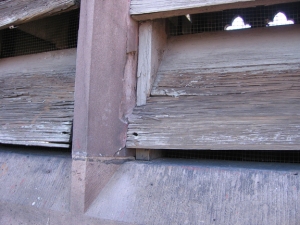Each week we’re bringing you an in-depth look at one of the standard conditions we encounter and document during inspections of buildings and civil structures.
Part 18: Wood Conditions
Wood is one of the oldest architectural materials. In historic and modern exterior applications, wood may be used in the form of structural timbers or dimensional lumber, roof and wall cladding or underlayment, carved or turned decoration, as a component in door and window assemblies, and in balustrades and railings.
Wood conditions include biological growth, which includes both lower plants (fungi, lichens, algae) and higher (vascular) plants; sound and failed coatings such as paint; cracking and checking; infestation by insects or mammals; abrasion, weathering, and rot; sealant failure; sound and failed patch repairs and dutchman repairs; various types of soiling; and unsecured wood due to failed fasteners.
As a plant-based material, wood is subject to some types of deterioration that do not affect other building components, such as rot and insect damage. Rot, which is a type of fungal attack, requires moisture and often occurs when wood elements aren’t adequately protected from the elements by paint coatings or weatherproofing details. Abrasion is wear on the surface of wood from foot traffic, handling, or contact with moving parts such as hardware. Weathering occurs due to exposure to wind-blown dusts, water and ultraviolet light, resulting in discoloration and/or surface loss. Often, the wood’s softer seasonal growth is lost at a greater rate than the denser seasonal growth, resulting in an uneven surface texture. Cracking occurs when wood yields to external stresses, often as a result of weakening by other forms of deterioration. Checking, on the other hand, is splitting along the wood grain caused by drying, and does not typically affect the strength of the wood.
Next in this series: Slate Conditions
Click here to see all posts in this series.
Click here for an index of all posts in this series, or download a pdf of the complete series.


